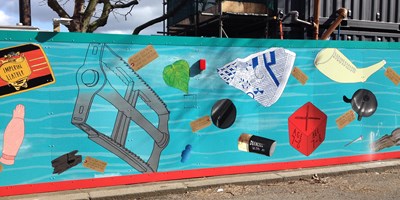#14daysofwashingup
an artwork created by Amy Pennington in collaboration with residents of Putney, commissioned by Tideway
About the work:
The large-scale artwork #14daysofwashingup is the result of a series of workshops organised by the artist Amy Pennington in August 2017, which ranged from mudlarking (scavenging the river mud for treasures), drawing and sculpting, to exploring the value of collecting and collections, and a roaming performance by Putney Pier. The workshops featured mudlarking expert Steve Brooker, star of the History Channel show ‘Mudmen' as well as the archivists from Battersea Arts Centre's (BAC) Moving Museum. These activities took place over a period of a fortnight during low tide at Putney’s foreshore.

The mud of the River Thames is anaerobic, meaning it is free of oxygen, and is therefore able to preserve any of the objects it contains in perfect conditions, much like a museum that preserves its collection. On average only one percent of a museum’s collection is on display, and likewise the Thames washes up only small fragments of its rich stores at any given time. The practice of mudlarking dates back to the late 18th and 19th centuries when mudlarks, usually young boys or agile elderly would hunt the banks of the Thames for anything that could be sold. Most often river-dwellers living in poverty, mudlarks could scrape by and make a living in this way.
Amy’s mudlarking resulted in a new collection of objects all found at Putney that connects the area to a rich history of trade, river passages and leisure activities and speaks of our habits as consumers over the last three centuries.

The artwork features hand drawn objects from this new collection such as clay tobacco pipes, horseshoes, bones, 18th century pottery fragments and broken toys, accompanied by labels that offer unexpected, imaginative insights into these finds. Some of the texts on the labels were written by participants of the workshops and further developed by the artist. Contemporary items are arranged next to Victorian pieces, exposing an unpredictable display of liquid history.













